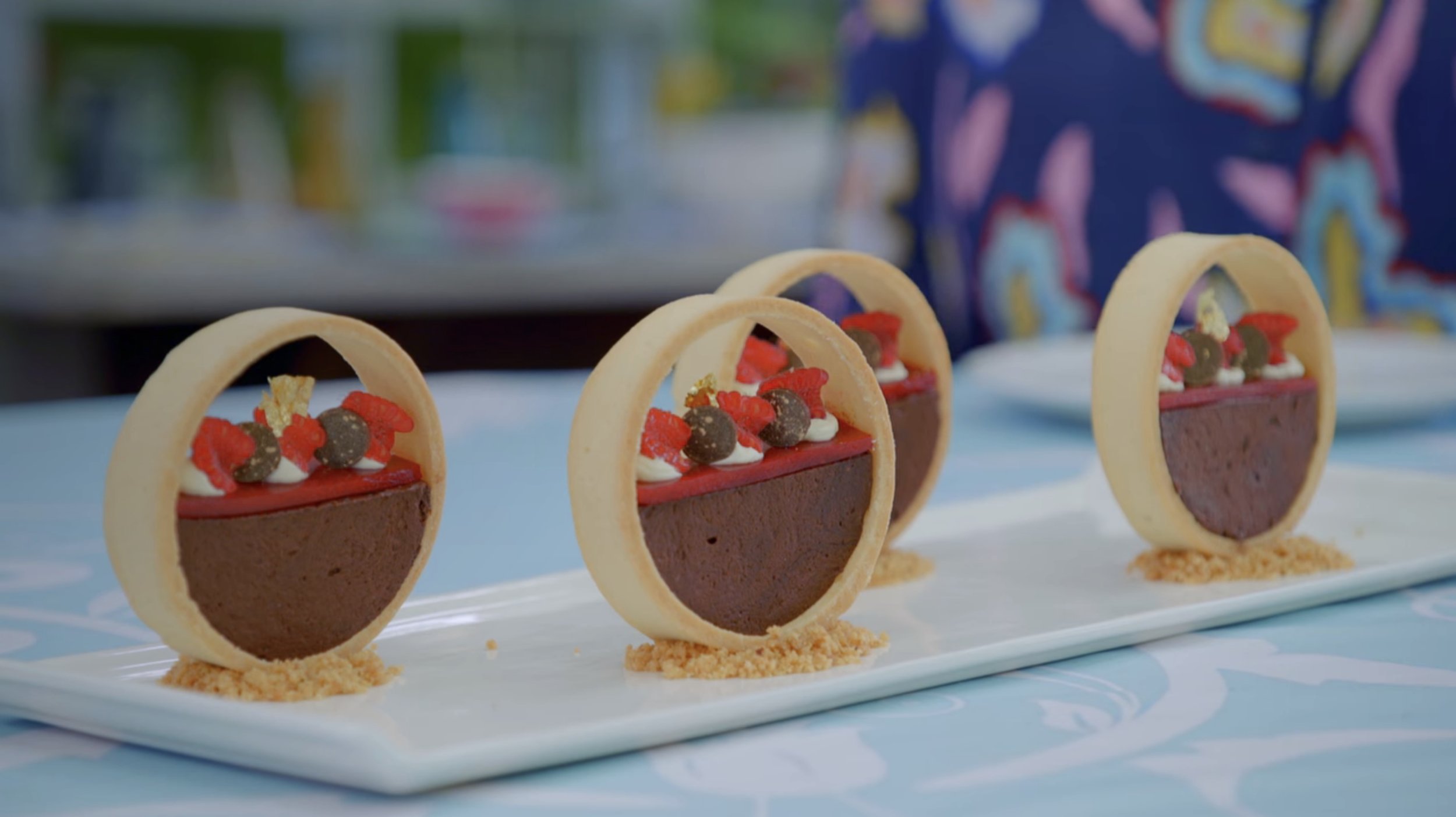Welcome to a new series called The Not-So-Great Defector Bake Off, where Kelsey and Chris attempt to complete the technical challenges from the newest season of The Great British Bake Off in their own home kitchens, with the same time parameters as the professional-grade bakers competing on the show.
We've done eight weeks of this foolishness—eight weeks of non-stop thrills, chills, and spills; of inadequate decorating skills; of the occasional use of spice mills; and of no small amount of ill will for the show's hosts, Prue Leith and Paul Hollywood, for forcing us to make pastries for Bread Week, spring rolls for Pastry Week, and goddamn Spicy Beef Tacos for Mexican Week. Through it all we have persevered, and at last we find ourselves at the greatest of all baking challenges: Patisserie Week.
Bread has its simple, rustic charm. Cakes are a crowd-pleasing delight. French patisserie-style baking is baking at its very most finicky, and even away from the competitive framework of The Great British Bake Off, the emphasis on aesthetic precision and fine-detailed presentation means a lot of sweet treats that seem to exist to gratify the baker more than to satisfy whoever is doing the eating. It means a lot of fantastically complex desserts that look amazing in a shop's window but aren't all that fun to eat. In general this is not a kind of baking or eating that the Not-So-Great Defector Bake Off would be drawn to, but as bold competitors we are of course thrilled to face this test of the skills we've gained and honed over the course of this series. We may not be patisserie-grade bakers, but then again, perhaps we are? Perhaps in fact we are the greatest bakers on the planet! Only one way to find out!
It's also nice to just have the chance to finally fucking bake something, after so much stove-top work. Since the end of Bread Week, the majority of baking challenges presented by Prue and Paul have included zero baking. The five bakes we've been asked to complete since Bread Week have required the making from scratch of 20 separate elements, and just two of those elements have been baked. Two! Things like meringues, marshmallows, and custards are fine baking-adjacent challenges for a baking show, but over this stretch we've spent as much time stir-frying and deep-frying as we have baking. Our ovens are cold and neglected. Frankly, we're a little sick of this shit.
After this—assuming we survive—all that lies between us and ultimate baking glory is the final, which for sure will be challenging, but all true Great British Bake Off heads know the final is all about the showstopper bakes. So now we plunge headlong and ravenous into this stiffest and most complicated of technical challenges: Prue Leith's Chocolate, Hazelnut, and Raspberry Vertical Tarts. Greatness awaits.
Chris Thompson: Kelsey, almost out of habit, my initial reaction to learning that we were expected to bake something called a “vertical tart” was to become extremely pissed off, as if I’d suffered an injustice. What was your first reaction to this challenge?
Kelsey McKinney: I think I must have audibly yelled, “You’ve gotta be shitting me.” Because Trey came running into my room and I was just gesturing wildly at your message that said “vertical tart.” I’m still mad, to be honest.
CT: It’s funny to me that we responded this way. When I first thought up this ridiculous undertaking, I knew of course that Patisserie Week would come, and as far as I can recollect I was looking forward to having my ass kicked by whatever insane, expert-level challenge came with it. I think what has happened over the course of the season is because we have had so much bullshit thrown at us, we have become more and more desperate for a challenge that involves baking something familiar. I guess the other contestants probably feel similarly.
KM: I think we had very reasonable responses. I wanted to make a lovely layered something that needed to be chilled. I was also looking forward to making something that ended up looking like trash but should have looked French and fancy. Of all the recent challenges, this one was the closest to a reasonable baking challenge, but we are tired and cranky. If we had been baking all season, this might have been exciting instead of infuriating. But I’m not sure if that’s just an optimistic stance.
CT: Possibly. One thing is for sure: In my life, I have never heard of or seen or even imagined something called a “vertical tart.” The best my imagination could conjure was, like, a fruit tart, but just like standing on its side. Which turned out to be not so far off the mark.
KM: One leg-up we do have on the contestants is that we know what we are making before the timer starts, so I had a full 24 hours to be mad about having to make this “vertical tart” before trying to figure out how to actually bake it. This does seem like a real advantage when your primary reaction is fury. Before reading the instructions, I did imagine it would be three tarts stacked on top of each other, which seemed exciting, like a layer cake. I was a little disappointed that it was much stupider than that.
CT: It was indeed stupider than that. I will say, once I looked over the method, I was actually a little bit relieved that the challenge appeared to involve more-or-less normal baking/cooking tasks. Mix dough and chill. Make mousse. Make jelly. Roll dough. Bake. Assemble.
KM: We got to use the oven this week! That’s something I liked. I also do find the timing challenges to be interesting. There were so many things to do for this challenge! So many little problems to keep in your head at all times.
CT: Yeah! The challenge, as far as I understood it prior to actually doing the bake, was essentially a logistical one: To manage five or six different overlapping tasks without losing a handle on any one of them. That turned out not to be wrong exactly, but to have underestimated the precise demands of the individual tasks. It was less that there were a lot of balls in the air, and more that some of the balls were in fact delicate soap bubbles that could explode at any time.
KM: I will do some foreshadowing here, and say that I lost a handle on one of them and had to do it again, but at this point in the season I am now good at making things twice, so that’s just part of the game bay-bee. No problem for me, a professional amateur baking show recap stunt blogger.
CT: How was your confidence in the hours and days leading up to the bake?
KM: This is an interesting question. My confidence was 100 percent. Incredibly, my confidence has not dropped at all. Every week, I am convinced that I will destroy the challenge. And every week when I am inevitably proven wrong, I find some flaw in the ingredients or supplies to point at and blame. According to me, I am perfect. How was yours?
CT: I am ashamed to admit that my confidence was also brimming at the start of my bake. This is the most complex thing I have ever made, and yet I felt super-duper certain that I would nail it, and in fact would outperform the show’s expert-level contestants. Amazing.
KM: What’s funniest about this is that I have absolutely no confidence for things I have proven over and over again that I am good at. For example, I am terrified every episode that I will bomb the Normal Gossip recording. But this? A game show that I am not qualified for and also consistently fail at, I feel like an Olympian before. The human psyche is terrifying.
CT: This will become more and more obvious as we get into the deeply stupid ways that you and I managed this challenge. Shall we?
KM: Yes. We shall.
Ingredients and Shopping
KM: I would like to begin, if it is OK with you, by discussing some decisions we made before the bake even began.
CT: I feel that would be appropriate, in the sense that often the events that cause a plane crash are set in motion hours or even days before the flight itself.
KM: I actually do think that this week, we had some reasonable disadvantages that we had no choice but to accept. The main one was that we did not have the little tart pans that the recipe required. Specifically, it wanted us to have many small round tart pans. I don’t even know where to buy these, so we did not. What we decided upon was to create our own tart pans out of tinfoil. Tell me what method you used for this.
CT: Well. The recipe calls for two 8cm tart rings, and four 9cm pastry rings. I knew that I would not purchase such things, because under no circumstances would I ever use them again after this bake. But I also knew that I would not be able to make the tarts without these rings. What I did was I made two shallow cups out of aluminum foil, measuring approximately 8cm in diameter. And then I made four rings out of aluminum foil, measuring approximately 9cm in diameter. The word “approximately” is doing a lot of work here, because in order to form the cups and rings I just used a juice glass and a plastic shaker bottle, which seemed to have the right relative proportions but which I did not measure.
KM: It would have been a stupid thing to buy! What I did was fold up the tinfoil so that it was kind of thick, and then I made six rings, four of which were slightly larger. None of my rings were actually circles, either. That feels important. “Ring” is also a broad word. I didn’t even wrap mine around something. I was just going on vibes alone, straight to hell. For my two smaller rings, I placed a sheet of tinfoil on a tiny baking sheet. I had to make a small tray out of tinfoil for the jelly because I also did not have this. Here is a picture of all of my tinfoil objects:
CT: I went with cups instead of rings for the two smaller ones because I gathered from the method that they would be used for holding mousse, and I thought there was a very high likelihood that my foil rings would not be precise enough along the bottom edge to keep the mousse from oozing out and spreading. This turned out to be perhaps the only good decision I made in the entire bake. Also I lined the cups with acetate along the sides and bottom, again reasoning that this would make it easier to remove the mousse. I too have a picture of my homemade tinfoil implements:
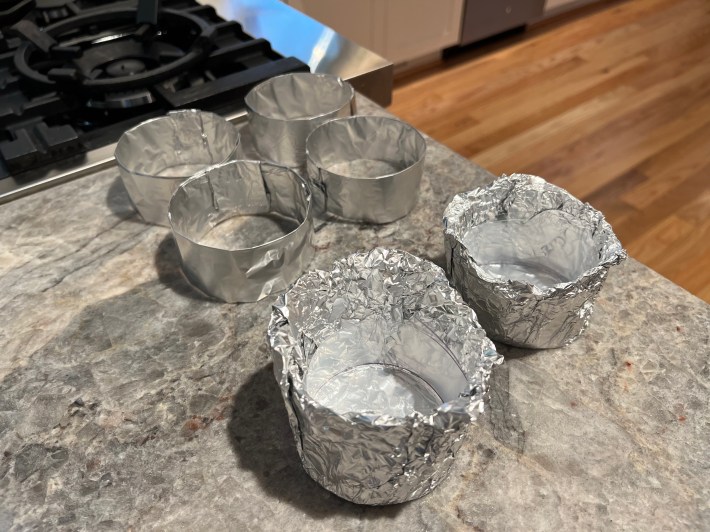
Hard as it may be to confess, making these clumsy things caused my confidence to soar. I imagined myself acing this challenge and claiming a victory for true at-home bakers, who naturally would not have full sets of cast metal tart tins for the making of vertical tarts.
KM: Wow, your rings look really nice and solid. Making my rings also caused my confidence to soar. Perhaps we are just stupid. That is becoming the only thing that makes sense to me. I do have something embarrassing to admit about the acetate situation.
CT: I think we are beyond embarrassment here.
KM: See, you say that. But I went to the Michael’s near me and they were out of acetate! I was mad about this, but not mad enough to go to another craft store. I then imagined what this acetate would be used for, and decided that I simply did not need very much of it. There was some acetate in the little windows of a couple boxes of dried goods that I had in my fridge, so I just ripped those out and used those for the chocolate decorations. I did not, however, line my mousse tins. There was not enough acetate for that, and also I didn’t want to.
CT: To me, the party that should be embarrassed right now is Michael’s! To not have acetate in stock and to still call yourself a craft store! Disgusting.
I did not buy gold leaf or edible gold spray for this challenge, as I view those ingredients as ostentatious and disgusting. Instead, I bought a small plastic jar of gold-colored sugar stars. I cannot overstate here how confident I was that my tarts would be beautiful, and that these stars would be like a thumb in the eye of Prue Leith, for thinking that you would need anything as tacky as gold leaf to beautify a well-made dessert.
KM: I did not buy any gold things because I assumed I could do without them. I would simply make a perfect … uh … a perfect … that’s right … VERTICAL TART. No problem.
Stage One: Measuring, Mixing, Mousse, and Jelly
CT: How did you start this bake, Kelsey? And how quickly did things go sideways for you?
KM: Once I had all my tinfoils ready, I hit the timer. At first, things were going pretty well. The crust went rather well. I decided to blitz my almonds in a spice grinder, add them to the flour, sugar, and butter, and throw all that shit into the food processor. Because I think this kind of shortbread crust is very finicky, I didn’t really trust myself to knead it by hand. So I just blitzed it until it was very fine, and then added the egg. I had to add a little bit of cold water to get it to really stick together, but it tasted like butter (which I love), so I was feeling great about that part. Did your dough come together OK?
CT: I also went spice-grinder mode on the almonds (and later on the hazelnuts), and used the food processor. I did not think to add water to my dough, so the only moisture in there was one egg yolk. This freaked me out, but this is where my absolute determination to follow instructions took over. I dumped the very crumbly dough out onto a sheet of parchment, balled up the parchment in order to smush the dough together, and then wrapped the dough in cling wrap and then into the fridge. The Slack record indicates that this took me a total of nine minutes. I was feeling fine, like I had everything in hand.
KM: Something happened to me during this bake where the spirit of Chaos Mode overcame me. I sent no Slack messages from the time I began until a full hour later. I also took no photos, so I must go based on my patchy memory to understand what happened after I put the dough in the fridge.
CT: Hilariously, I intended to take notes as the bake went along, but that turned out to be just absolutely fucking hopeless. I assume you went from dough straight to mousse? How did this go for you?
KM: I did, and I had several problems. I decided that I needed to whip the eggs in the Kitchenaid and add the caster sugar to this, making the stiff glossy peaks we are always making. While the eggs were whipping, I tried to melt the chocolate and Nutella and the Frangelico and the gelatin and it just ... became a brownie. I’m still a little unclear on how this happened. I was watching it very carefully and it was on very low heat, and it became so, so thick.
CT: I had the exact same experience, and it flustered me so badly. I have made mousse before, successfully, and I understand the principles well enough. You have to temper egg yolks in your mixture, and then fold in whipped egg whites. And I have successfully melted chocolate in a double boiler before. But what I have not done is melt chocolate with hazelnut paste and Frangelico in it, and evidently I do not understand the principles of this exercise at all. My first try bricked. My second try bricked. For my third try, I melted just the chocolate and Nutella, which went fine, and then added the Frangelico, whereupon it immediately bricked.
KM: Me too! It was the part I felt second most confident in after the jelly, but then I made a brownie! Because this was obviously not working, I threw it away. At this point, I was like, I might as well make this stiff glossy peak while I regain my cool, and then that ALSO did not work. For the first time this season, it became soupy instead of stiff after I added the sugar. So I threw all of that away. I began the mousse again: set the egg whites whipping, and then chose to melt the chocolate and the paste and the gelatin this time in the microwave with a tad of heavy whipping cream. Once the chocolate was melted, I added the other things. Yet again, I made a brownie!!!! The third time, I melted the chocolates, and the gelatin (this was the end of my gelatin so I did not get another attempt) then added the Nutella, and I added the Frangelico to the egg yolks. I was throwing spaghetti at the fridge by that point. But it didn’t brick fully, so I declared it good enough.
CT: My fourth try had to be my final try, because I had no chocolate left. I melted just the chocolate. When it was smooth and glossy, I added just the egg yolk. Then I added maybe one single drop of Frangelico. It instantly fucking bricked. Here I came very, very close to sobbing, closer than any adult should ever come to sobbing over mousse. But I had no more chocolate, so this would have to be my mousse. I stared at it for a minute, and then I dumped the rest of the Frangelico into the mud, and the Nutella, and just smashed it around for a minute. Then I dumped the egg whites in there and smashed those around, until I had a lumpy brown spackle in my bowl. I then spooned this awful nightmare shit into my foil cups and threw them into the fridge. I could not FUCKING BELIEVE that I still had another hour-plus of cooking in front of me, and of knowing the entire time that I had already failed.
KM: To be honest, I still don’t really know how we should have done this. It’s unclear to me why the Frangelico did this. At this point, I poured a nice healthy pour of the Frangelico into a little cup and began to sip it. I ended up pouring more heavy cream into my far too thick chocolate brownie mix, and then just folded it into the egg whites. I don’t fucking know. I poured these into my tins, and I went into the freezer with them. I’m not sure why I chose that. It felt right in my heart.
CT: More than 10 minutes passed after my "mousse" went into the fridge—I was midway through making my raspberry jelly—when I realized that I never added the gelatin to the mousse.

I knew that it would never set without the gelatin, so I had no choice but to yank it out of the fridge, slop it out of my foil cups back into a bowl, and stir in some melted gelatin.
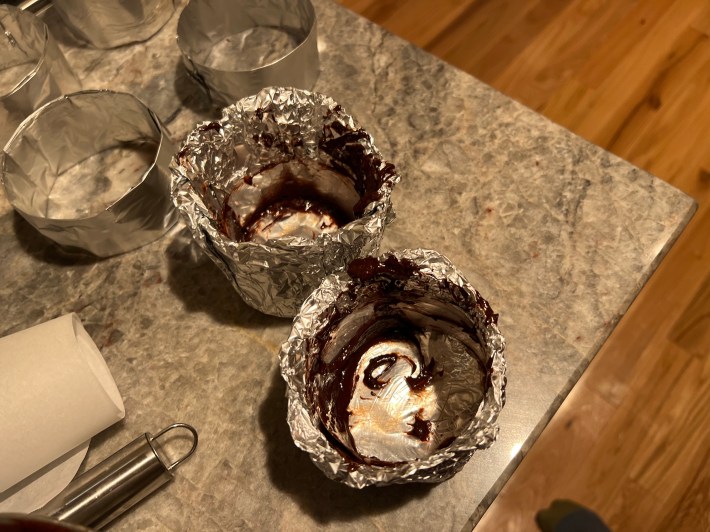
I used a little bit of water to melt the powdered gelatin, and this little bit of added moisture gave the chocolate sludge a somewhat more recognizable pudding-ish texture, but it also inevitably killed whatever pathetic structure was left from the whipped egg whites. I grimly slopped it back into the foil cups and put it back into the fridge, sort of vaguely hoping that it would vanish from existence over the course of the following hour.
I might as well admit that I was basically gulping down sobs this entire time.
KM: No! No!!!!!!!!!!! This is a nightmare! Chris! You should have simply been gulping down Frangelico like me. I am truly sorry about your gelatin. That is a nightmare I would not wish upon my worst enemy.
CT: It felt bad! But jelly-making is a simple, happy task, and it restored my state of mind somewhat. The mixture came together in no time. It felt a little loose when I poured it into my dumb little homemade foil tray, but I had confidence it would firm up in the fridge, and it did.
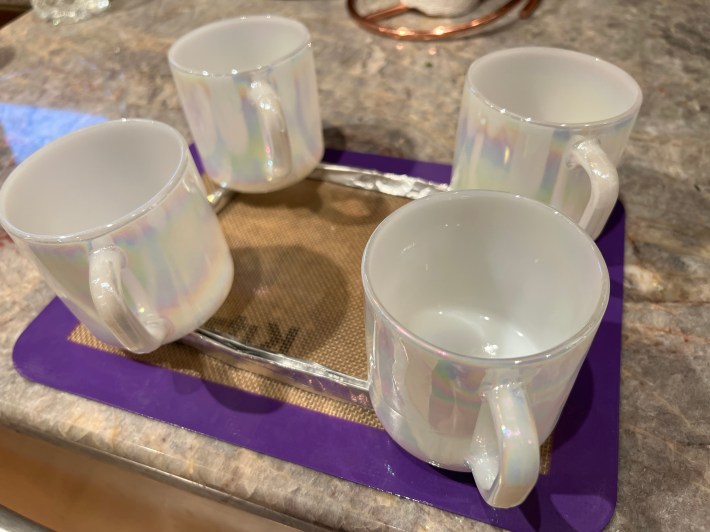
KM: I am not sure how this happened, actually, but when I was done with my mousse, I was also done with the jelly. I think in my blind rage over the brownie situation, I began making the jelly, which I knew I could do in my sleep. Being a southerner does have perks and one of them is that when my mousse went into the fridge, the only thing I had left to do was get the seeds out of the jelly. I knew I had to do this because the instructions specified “smooth” jelly. So i put my jelly through the little sieve that I have and then put it into the little tray I made for it and threw it into the fridge. At this point, though, I had a panic attack, because I went back to the method and I was only done with three of the 13 steps and I was so tired and so stressed. I made a cup of coffee. It was 5 p.m. This was a mistake, but one I had to make.
Stage Two: Rolling, Chilling, Baking, More Measuring, and More Mixing
CT: This is when I pulled my dough out of the fridge. I felt by this time that I was incredibly far behind schedule, but I was too terrified to check the timer.
KM: Same! The dough, though, tasted great. I kept having little bites of it and that made me feel a little better.
CT: So I pulled my dough out and threw it down on parchment, slapped another sheet of parchment on top, and rolled it out thin. Then I used the straight edge of a sheet of acetate to trace and cut four strips of roughly the dimensions described in the recipe. I gained confidence from successful rolling and from the aesthetic cleanliness of straight parallel lines. Misplaced confidence, yes, but fortifying for a rattled psyche.
KM: Before this series, I was always making things harder for myself. I never used parchment paper. I was always flouring and getting things stuck. Now I’m addicted to parchment paper. It’s my one true love. I did the exact thing you did, rolled it out thin. But the “freeze for 20 minutes” on the instructions freaked me out, so I just eyeballed the measurements and the cuts. It was very hard for me to get the shortbread into the rings. It kept breaking!
CT: Kelsey, it was SO BRITTLE. I didn’t realize this at first, when making my cuts. Then I slipped a thin spatula under the first strip and tried to peel it off the parchment and it broke precisely at the edge of the spatula, instantly. My blood ran cold. The dough had zero elasticity. I suppose I should have anticipated this, since shortbread cookies are famously crumbly, but the moment that my first strip just like blew apart when touched was perhaps as defeated as I have ever felt in my entire life. All hope left me. Not just baking hope. All hope for our species and indeed our very solar system. Gone.
KM: I wanted to just eat my dough, because it had the same texture as those slice-and-bake cookies. It was extremely hard for me not to eat all of the dough. I am very, very brave. After two tries, I gave up on getting them in the rings in a beautiful manner and instead just dropped them in there and smushed them together with my fingers.
CT: I tried several different methods for fitting the strips into the rings, and none of them worked. It was here that I encountered the ultimate stupidity of replacing solid pastry rings with flimsy foil rings: You cannot press dough into the sides of a ring made of aluminum foil without reshaping the aluminum foil. My carefully constructed rings became ugly foil amoebas with just chunks of crumbly shortbread dough haphazardly smashed along their interior walls. This also took me far, far longer than I could afford to lose.
KM: How much time do you think you had left when your rings went into the freezer?
CT: Maybe about 57 minutes? The Slack record indicates that they went into the oven with 35 minutes to go, and I think I did give myself the full 20 minutes of freezing.
KM: OK, I think we were about at the same place, then! Based on the Slack record, I had 30 minutes left while they were in the oven, which means I put them in the freezer at least 20 minutes before that. I made sure they had the full 20 minutes next to the mousse in the freezer, and they came out frozen! Because there was a brief pause in scary things to do between the freezing and the baking, I again became confident. Why am I like this?
CT: I think this way of being is only bad in the narrow case of having to share your failures with an audience of many thousands of subscribers.
I used the 20 minutes of freezing time to make the hazelnut crumble, which was very easy. Just some dry shit and some butter mixed together and then thrown into the hot oven until done.
KM: Yes, same, and on top of being easy, this also tasted great. I was feeling good about the taste of the final product, if not its appearance. Hazelnuts are so expensive, so I watched the crumble like a hawk and it turned out nice and crispy and delicious.
CT: I don’t know if my pastries were quite frozen when I put them in the oven, but I didn’t feel I had even a moment to find out. I lined them with parchment paper and then poured rice into their centers, to keep the dough pinned to the side as it heated up. I’m not sure whether this was exactly right, but I am 100 percent certain that my particular way of doing this was wrong, as we will soon see.
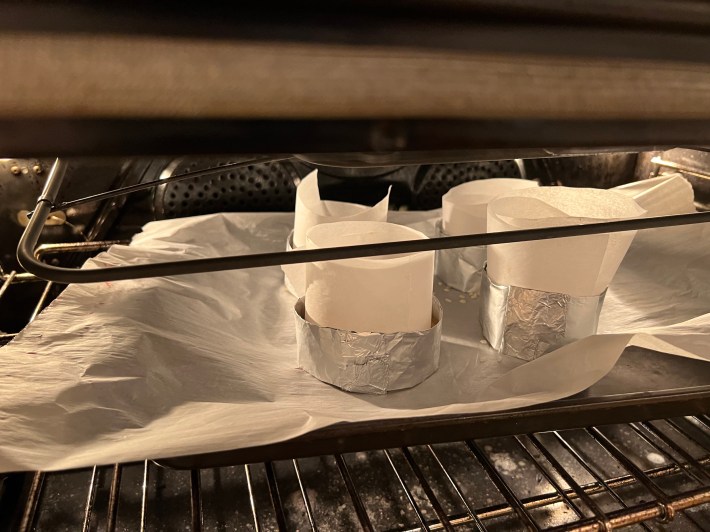
KM: I also did that! But my way was also wrong for what I imagine is going to be the same exact reason lol. I wish I had lined the ring before I froze it, but I have all sorts of way I would like to change the past.
CT: As soon as the pastries went into the oven, I started tempering the chocolate for the decorations. This involved carefully melting the final bits of chocolate in my home, which thankfully I’d set aside prior to the start of the challenge or they would’ve been lost in the Mousse Incident. You melt the chocolate and then you spread it over a thin sheet of acetate, and then you allow it to cool until it can be cut into shapes, and then you cut it into shapes and cool those shapes until they are fully solid. I found this to be reasonably straightforward, even if I cooled the chocolate too much and wound up having to cut it in less than ideal conditions.
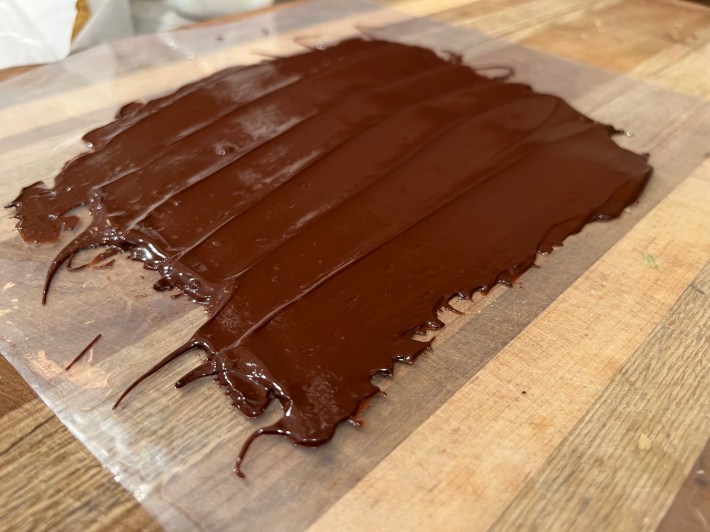
KM: I also did this! It was easy! I put the chocolate on my weird-sized squares of acetate that I stole from the boxes, and it worked fine. I didn’t have the circle stamp, so I cut out triangles. Triangles are fun!
CT: Yeah! I did circles, but as we will soon see, none of this matters.
An issue that I ran into is that I could not seem to get my pastries to bake? In a hot oven? At first I did not fully appreciate the gravity of the situation. I had lots of time and I thought even if a 15-minute bake ran long, I still had 20 minutes to get my pastries done.
KM: I also had this problem. I even upped the temperature of the oven to 400 and they still didn’t bake enough. I checked at 10 minutes and they were still so soft. Basically, they had just returned to their pre-frozen state. I ended up baking for 25 minutes before I literally had to remove them so they would have time to cool and they were STILL not baked. Tell the people what your wife said. I think she was correct.
CT: So her theory of why my pastries refused to bake has to do with the fact that foil does not hold or transfer heat precisely the same way that a solid baking tin would. This has the ring of truth to it, even if I have done nothing to confirm the science of it. But whatever the case, my pastries did not bake in 15 minutes. I pulled them out of the oven after 20 minutes, and discovered that they still had not baked.
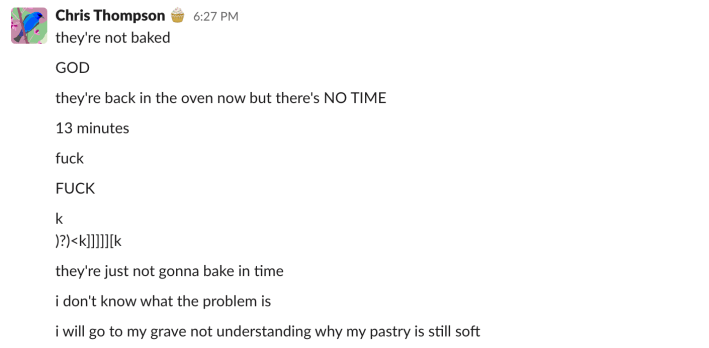
I only discovered this because I removed the foil from one of them, whereupon the weight of the helping of rice that I’d put inside of it overwhelmed the flimsy underbaked shortbread and caused the dough ring to crumble apart in like 19 places. It was as if the rice had multiplied exponentially in the oven. Rice everywhere. Rice Hell.
I bumped the heat in the oven to an insane 450 degrees, and socked all four of them back in there, one of them now almost completely covered in a pile of loose rice.
KM: Oh, so we did have different problems! I pulled mine out and they were still smushy, but I refrigerated them, because I had no choice. Then when I began to assemble, I took the rice out and found that the rice had baked into the edge of many of my rings!! So there was just rice stuck to the inside!
CT: I pulled my rings out of the oven with five minutes left on the clock. By this time the three that were not covered in rice were “caught,” as Paul Hollywood would say, along their upper edge. The rice was a huge problem. Because I’d put so much of it in there, and because it was just held in place by an open-bottomed ring of parchment, there was no way to remove the extremely brittle dough rings without exposing them to the weight of the rice.
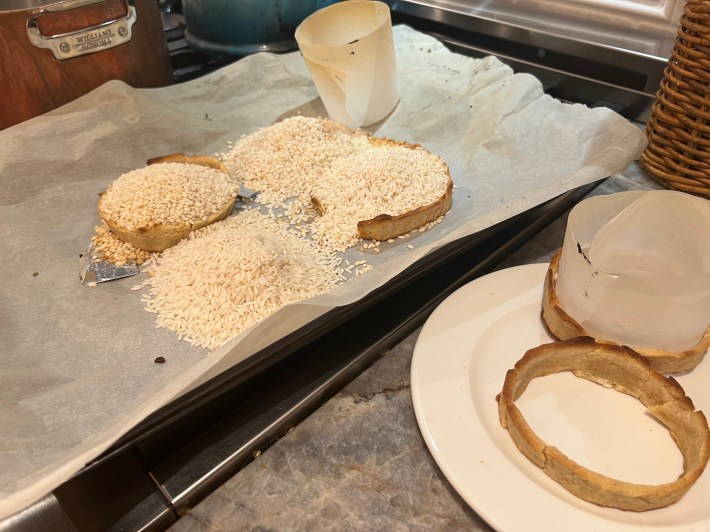
I considered using a vacuum cleaner to remove the rice from the center of each ring without moving the ring, but as the vacuum is stored in the basement, I quite literally did not have time for this. So I used a slotted fish-turner to lift the pastries and let the rice run out the bottom. Needless to say, this caused a lot of destruction, but by this time I was already in Hell.
Stage Three: Assembly and Decoration
CT: My pastries were in no condition to stack vertically, or really in any other orientation. How about yours?
KM: Well. For one second, I believed they might be OK to stack vertically, because I forgot that the mousse would be heavy and there wouldn’t be anything to support the top of the ring except for the strength of the shortbread. So I initially stood one ring up on its own, and it settled a little, and I thought it would work! But, frankly, I didn’t have much time to consider whether the assembly was going to work because I was running out of time! How were yours?
CT: The one that finished baking under a pile of rice was fully blasted apart, and like yours had rice embedded in it. Two of the remaining three crumbled as I lifted them with the fish-turner. The fourth I dared to believe could be presented successfully. But I knew that the challenge overall was going to be fully a disaster when I removed my “mousse” from the fridge and it was this disgusting fudgy mess. I’d never had much hope with the mousse, but to see that it had settled as this thick congealed mud was powerfully disheartening.
KM: No! No no no! I also had the same problem with the mousse. Mine was fudgy. I did not like the way it looked. In my opinion, it was much too dark to be satisfying and much too dense. I hated it immediately.
CT: To make the tarts, you cut each circle of mousse in half to form four semicircles, then you rest each semicircle of mousse inside a ring of pastry and top it with a layer of jelly, then you decorate. But as I had only one intact ring, I focused all my attention on just getting this one ring correct. My method was to lay the ring flat, rest the semicircle flat inside it, top the mousse with a layer of raspberry jelly, and then lift the whole thing as one piece and carefully rest it on its little stand of hazelnut crumble. This went well until the moment the pastry ring touched the hazelnut crumble and instantly broke apart into six pieces, and the whole thing fell onto the plate in a heap.
KM: My method, because my fudge was so sticky, was the opposite. I propped a ring up with the crumble, and then I used the offset spatula to whisk the mousse into the little circle. I kind of smashed it into there. That worked fine but immediately my circle began to collapse and become an oval. I ignored this. I cut my jelly into strips and put this on top. That part also worked, but my circle was collapsing, so I took the whipped cream I had left and filled the space between the jelly and the top of the circle in the hopes that this would give it some stability. It did not. It continued its slow-motion structural failure.
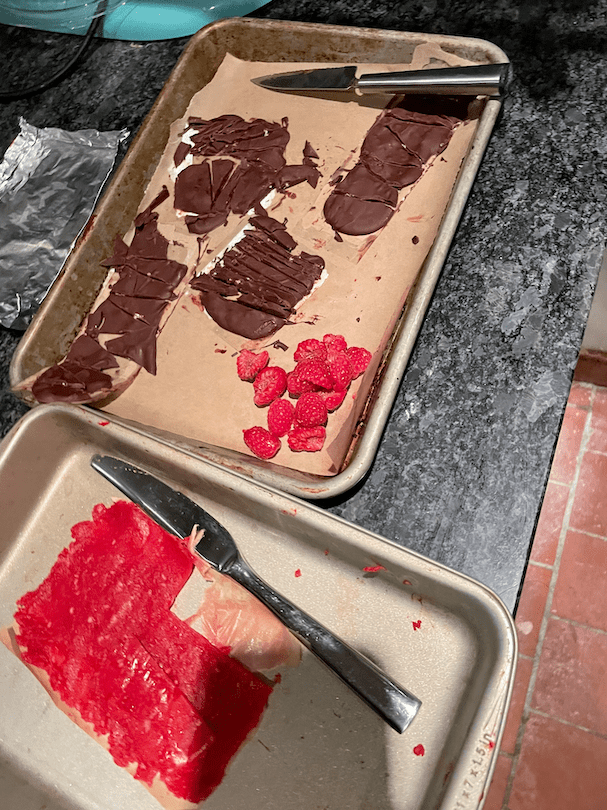
CT: It’s funny that our bakes both collapsed, but yours collapsed slowly and mine collapsed all at once. If there’s a right way to do this, we did not discover it. I left the awful pile of destroyed tart where it fell and just quickly made three more equally awful piles out of my remaining components, decorating with whipped cream, chocolate circles, and gold stars the way autumn “decorates” my yard with fallen leaves.
KM: I personally believe that we were destroyed by our failure to have the proper tins to bake the shortbread. I am forced to believe that if we had had those, we would have completed this to perfection. I decorated my tarts the way that a child decorates a wall with a crayon.
CT: Hmm, while I certainly prefer to blame the foil, this does not explain or excuse my abominable mousse.
The Finished Product
CT: This is a preposterous question, but: How did your vertical tarts turn out, Kelsey?
KM: I feel a little ashamed to admit that my tarts make me feel like a failure. They do not look good, they were imminently collapsing, and the mousse looked like some cartoon poop. Here, observe them:
How did yours turn out?
CT: Kelsey, if my tarts looked like your tarts, I would be six inches taller right now, and flying around my neighborhood on eagle's wings. Instead, they looked like this:

KM: Noooooooooo! The crumbling makes me want to cry.
CT: Every time I look at these photos of my tarts, they somehow become more crumbled and pathetic. It’s a whole Dorian Gray situation. Did you eat some tart?
KM: I ate two tarts greedily as if they were the only food I had managed to eat in weeks. I wanted to disappear them, to consume them and destroy them. Did you eat some?
CT: Not at first. When the timer went off I simply walked out of my kitchen and then out of my home altogether, and stood on my porch and stared off into nature. Then I came back inside and walked upstairs to apologize to my wife for the state of our kitchen and to invite her to please join me on the main floor of our home. She came down and saw the tarts and said “Oh dear,” in the manner of a veterinarian who has discovered that some poor family's pet must be immediately euthanized.
After fuming for a solid hour, I consented to eat one of the horrid monstrosities. It was absolutely delicious.
KM: Did your baby eat one? What was her take?
CT: She tried a few bites, and seemed to enjoy the “mousse,” asking for additional bites by pointing at it and saying “more chockee pees.” She did not have much interest in the shortbread, which had a burned taste and a not-super-pleasant sandiness to its texture. But the combination of raspberry jelly, dark chocolate sludge, whipped cream, and hazelnut crumble was a crowd-pleasing delight. I’m sure it would’ve been even better if the mousse had not had the texture of drying cement.
Do you have the sense that you could do better at this recipe on a second try, or perhaps with no timer?
KM: Honestly, no. I am hoping that watching the episode will help me understand, but I still have absolutely no idea what happened to the mousse or why it turned into a big brownie every time. I also don’t know that I could have gotten the rings right without the tins even if given all the time in the world. Honestly, the only bonus here is that now I have Frangelico and hazelnuts, which are delightful.
CT: Yeah! I put Frangelico in my coffee this very morning!
Kelsey, they say that the only chapter of this journey that is left to us is the finale.
KM: It’s really impressive that we have made it this far. Don’t you think? I’m proud of us. Our signature bakes have been really incredible.
CT: I don’t mind saying, one or two of my showstopper bakes have driven the judges to a state of speechless awe. Paul Hollywood asked me to adopt him and raise him as my son. I said no.
KM: It’s beautiful that we are entering the finale with a combined six star-baker awards, the most in show history, probably.
CT: An amazing accomplishment. Surely the final technical challenge will be a breeze.
